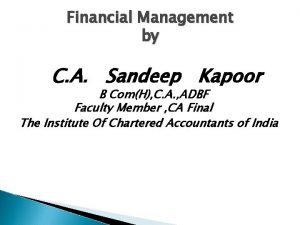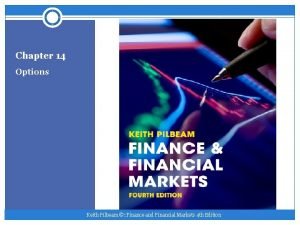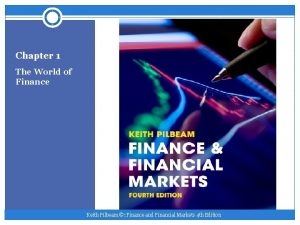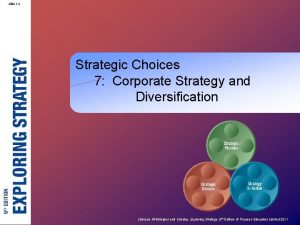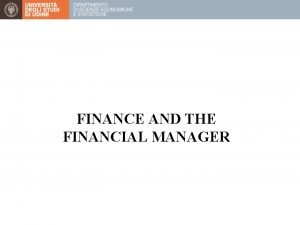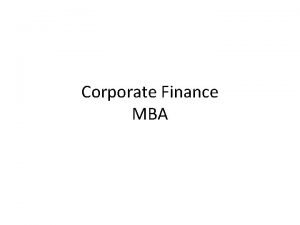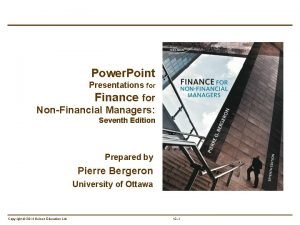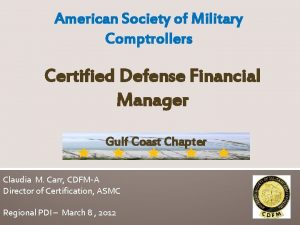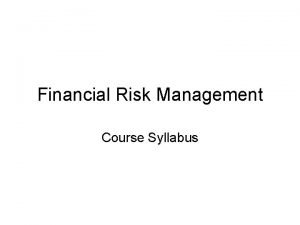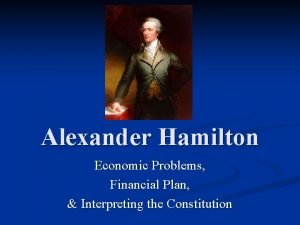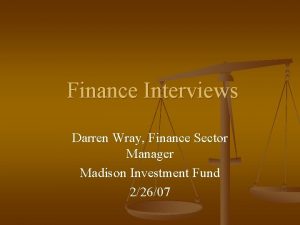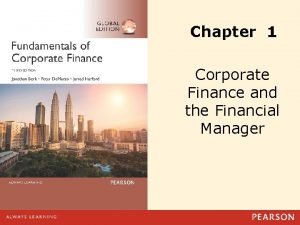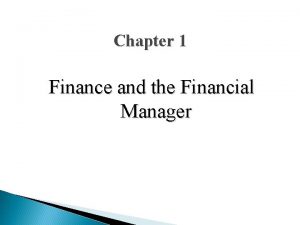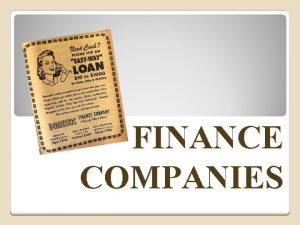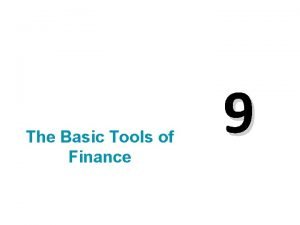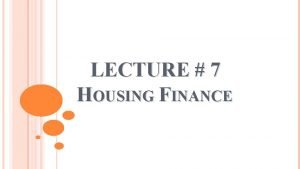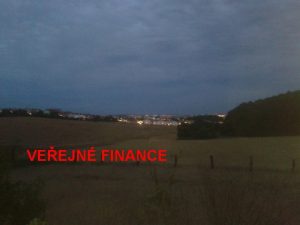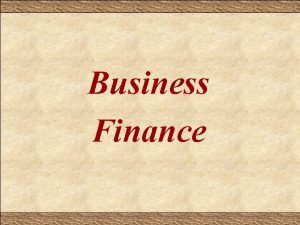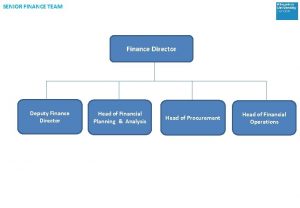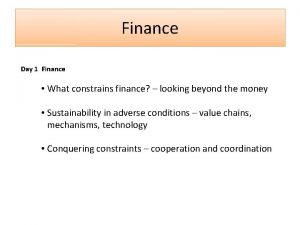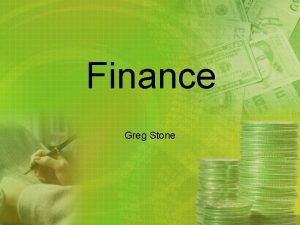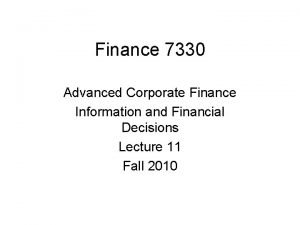FINANCE AND THE FINANCIAL MANAGER Outline What is
































- Slides: 32

FINANCE AND THE FINANCIAL MANAGER

Outline • • • What is a corporation? The role of the financial manager Who is the financial manager? Separation of ownership and management Financial markets

Introduction • Both big and small businesses are guided by the same corporate financial principles • Bigger businesses are run by managers • These managers are selected by the shareholders (owners of the business) • It is important to increase the wealth of the shareholders

What is corporate finance? • Every decision that a business makes has financial implications, and any decision which affects the finances of a business is a corporate finance decision. • Defined broadly, everything that a business does fits under the rubric of corporate finance. • Corporate finance is not just for investment bankers. No matter what you do, there is a corporate financial aspect to your decisions.

Major decisions in Corporate Finance • The Allocation decision (investments) – Where do you invest the scarce resources of your business? – What makes for a good investment? • The Financing decision – Where do you raise the funds for these investments? – Generically, what mix of owner’s money (equity) or borrowed money(debt) do you use? • The Dividend Decision – How much of a firm’s funds should be reinvested in the business and how much should be returned to the owners?

The role of corporate financial management • The process of creating value in a business by making the best decisions • Ultimate measure – to increase the wealth of the shareholders • Financial management ≠ Accounting • Accounting: a historical perspective (report) • Financial managers: use information from accountants to make decisions

Position of the financial manager in the corporate structure

The Financial Manager Responsible for: • • Managing the business’s cash and credit Financial planning Corporate expenditure Record-keeping

Corporate financial management decisions • 3 basic decisions: • 1) What should the business invest in? • 2) Where will the business get long-term financing to pay for the new investment? • 3) How will the business manage its day-to-day financial activities?

The first principles Maximize the value of the firm The hurdle rate should reflect the riskiness of the investment and the mix of debt and equity used to fund it. The investment decisiom The financing decision The dividend decision Invest in assets that earn a return greater than themminimum acceptable hurdle rate Find the right kind of debt for your firm and the right mix of debt and equity to fund your operations If you cannot find investments that make your minimum acceptable rate, return the cash to owners of your business The return should reflect the magnitude and the timing of the Cash flows as well as all side effects. The optimal mix of debt and equity maximizes firm value The right kind of debt matches the tenor of your assets How much cash you can Return depends upon current & Potential investment opportunities How you choose to return cash to the owners will depend on whether they prefer dividends or buybacks

Capital budgeting • Financial manager should aim to create value • Will do that by identifying investments that will create value • Determine cash flows § Size – how much initial investment is needed and how much income will be received § Timing – when and for how long income will be received § Risk – the likelihood of receiving the income • Will income from investment exceed the cost?

Capital structure • The mix of debt and equity a company uses to fund new investments/projects • Three choices available: § Borrow long-term funds (debt) – risk increase § Use savings of the company (retained earnings) § Issue more shares (equity) – ownership declines • Whichever option will have an effect (risk and value) • Which form of financing is the cheapest?

The first principles • Invest in projects that yield a return greater than the minimum acceptable hurdle rate. – The hurdle rate should be higher for riskier projects and reflect the financing mix used - owners’ funds (equity) or borrowed money (debt) – Returns on projects should be measured based on cash flows generated and the timing of these cash flows; they should also consider both positive and negative side effects of these projects. • Choose a financing mix that minimizes the hurdle rate and matches the assets being financed. • If there are not enough investments that earn the hurdle rate, return the cash to stockholders. – The form of returns - dividends and stock buybacks - will depend upon the stockholders’ characteristics.

The investment principle (1) • Firms have scarce resources that must be allocated among competing needs. The first and foremost function of corporate financial theory is to provide a framework for firms to make this decision wisely. Accordingly, we define investment decisions to include not only those that create revenues and profits (such as introducing a new product line or expanding into a new market) but also those that save money (such as building a new and more efficient distribution system). Furthermore, we argue that decisions about how much and what inventory to maintain and whether and how much credit to grant to customers that are traditionally categorized as working capital decisions, are ultimately investment decisions as well. At the other end of the spectrum, broad strategic decisions regarding which markets to enter and the acquisitions of other companies can also be considered investment decisions.

The investment principle (2) • Corporate finance attempts to measure the return on a proposed investment decision and compare it to a minimum acceptable hurdle rate to decide whether the project is acceptable. The hurdle rate has to be set higher for riskier projects and has to reflect the financing mix used, i. e. , the owner’s funds (equity) or borrowed money (debt). In the discussion of risk and return, we begin this process by defining risk and developing a procedure for measuring risk. In risk and return models, we go about converting this risk measure into a hurdle rate. • Having established the hurdle rate, we turn our attention to measuring the returns on an investment. In analyzing projects, we evaluate different ways of measuring returns. In extensions of this analysis, we consider some of the potential side costs that might not be captured in any of these measures, including costs that may be created for existing investments by taking a new investment, and side benefits, such as options to enter new markets and to expand product lines that may be embedded in new investments, and synergies, especially when the new investment is the acquisition of another firm.

The financing principle (1) • Every businesses ultimately funded with a mix of borrowed money (debt) and owner’s funds (equity). The existing mix of debt and equity and its implications for the minimum acceptable hurdle rate is part of the investment principle, • However we throw open the question of whether the existing mix is the right one in the financing principle section. We delve into to the question of whether the existing mix of financing used by a business is optimal, given the objective function of maximizing firm value. Although the trade-off between the benefits and costs of borrowing are established in qualitative terms first, we also look at two quantitative approaches to arriving at the optimal mix. In the first approach, we examine the specific conditions under which the optimal financing mix is the one that minimizes the minimum acceptable hurdle rate. In the second approach, we look at the effects on firm value of changing the financing mix.

The financing principle (2) • When the optimal financing mix is different from the existing one, we map out the best ways of getting from where we are (the current mix) to where we would like to be (the optimal), keeping in mind the investment opportunities that the firm has and the need for timely responses, either because the firm is a takeover target or under threat of bankruptcy. Having outlined the optimal financing mix, we turn our attention to the type of financing a business should use, such as whether it should be long-term or short-term, whether the payments on the financing should be fixed or variable, and if variable, what it should be a function of. Using a basic proposition that a firm will minimize its risk from financing and maximize its capacity to use borrowed funds if it can match up the cash flows on the debt to the cash flows on the assets being financed, we design the perfect financing instrument for a firm. We then additional considerations relating to taxes and external monitors (equity research analysts and ratings agencies) and arrive at strong conclusions about the design of the financing.

The dividend principle • Every business that thrives reaches a stage in its life when the cash flows generated by existing investments is greater than the funds needed to take on good investments. At that point, this business has to figure out ways to return the excess cash to owners: – Private businesses, this may just involve the owner withdrawing a portion of his or her funds from the business. – In a publicly traded corporation, this will involve either paying dividends or buying back stock. • We introduce the basic trade-off that determines whether cash should be left in a business or taken out of it. For stockholders in publicly traded firms, this decision is fundamentally one of whether they trust the managers of the firms with their cash, and much of this trust is based on how well these managers have invested funds in the past. Finally, we consider the options available to a firm to return assets to its owners—dividends, stock buybacks and spin-offs—and investigate how to pick between these options.

Working-capital management • Working capital = short-term assets and liabilities • How will you approach the day-to-day financial management? § § Will you sell new product for cash, credit or both? Who will receive credit and who won’t? How many days until debtors have to pay? Will you pay expenses in cash or on credit? • All these decisions are important to ensure business functions efficiently • There must be sufficient resources for adequate liquidity

The ultimate goal • The ultimate goal of corporate financial decision is maximizing the value of the firm

Corporate financial decisions, firm value and equity value • If the objective function in corporate finance is to maximize firm value, it follows that firm value must be linked to the three corporate finance decisions outlined. The link between these decisions and firm value can be made by recognizing that the value of a firm is the present value of its expected cash flows, discounted back at a rate that reflects both the riskiness of the projects of the firm and the financing mix used to finance them. • This neat formulation of value is put to the test by the interactions among the investment, financing, and dividend decisions and the conflicts of interest that arise between stockholders and lenders to the firm, on one hand, and stockholders and managers, on the other.

The goals of financial management • Most people believe main goal is maximising profit: § § § Increasing sales Increasing market share Minimising costs Increasing growth in profits Avoiding insolvency Surviving • BUT focusing on profitability ignores risk • Higher risk should correspond with higher return • Need more basic goal – shareholders’ wealth maximisation

Shareholders’ wealth maximisation • Number one goal = increase the wealth of the shareholders • How can that be done? § Shareholders can receive dividends § Increase in the share price • If a financial manager focuses on shareholders’ wealth maximisation, then both risk and return are taken into account • Profit maximisation: short-term goal not looking at longterm effects • Share price maximisation: short-term and long-term • Every decision in the best interest of the shareholders

Why focusing on max stockholder wealth? • Stock price is easily observable and constantly updated (unlike other measures of performance, which may not be as easily observable, and certainly not updated as frequently). • If investors are rational (are they? ), stock prices reflect the wisdom of decisions, short term and long term, instantaneously. • The objective of stock price performance provides some very elegant theory on: – Allocating resources across scarce uses (which investments to take and which ones to reject) – How to finance these investments – How much to pay in dividends

The Traditional Accounting Balance Sheet Assets Long lived real assets Fixed Assets Liabilities Current Liabilities Short-term liabilities of the firm Short-lived assets Current Assets Debt obligations of firm Investments in securities and assets of other firms Financial Investments Other Liabilities Other long-term obligations Assets which are not Physical (Patents, trademarks. . ) Intangible Assets Equity investment in firm

The financial view of the firm Assets Existing investments generating cash flows today (comprise long lived assets and short lived assets) Expected value that will be created by investments to be made in the future Liabilities Assets in Place Debt Growth Assets Equity Fixed claims on cash flows No involvement in management Fixed maturity and tax deducible Residual claims on cash flows, Involvement in management Perpetual lives

Corporate structure Sole proprietorships Partnerships Corporations Unlimited liability Personal tax on profits Limited liability Corporate tax on profits + Personal tax on dividends

The agency problem • Goal of financial management: increase shareholders’ wealth • Sole proprietorship = easy; owners are generally also the managers of the business • Big companies = difficult; owners/shareholders not directly involved in business • The shareholders (principals) appoint managers (agents) to look after their interest • Agency relationship: the relationship between the principal and the agent • Agency problem: when the agent does not make decisions in the best interest of the principal

Agency costs • Management and shareholders goals can differ • Agency cost: Any costs (both direct and indirect) that can arise due to the agency problem • Direct agency cost: measurable amount • Indirect agency cost: not physical, lost opportunity • Control agency cost: § Incentive plans § Performance plans

Financial markets and institutions Financial market: place where anyone with funds can transact with anyone in need of funds • • Money Market: short-term debt securities (no physical location) Capital Market: long-term debt securities (stock and bond exchanges) § Primary market: sell securities for the first time § Secondary market: securities traded after being sold in the primary market § Auction market: broker brings buyer and seller together (NYSE) § Dealer market: traders offer to buy or sell securities (JSE) Financial institutions: bring savers and lenders together to efficiently allocate funds (financial intermediary)

Flow of funds

Conclusion • Corporate financial management is the process of creating value in a business. • The financial manager needs to make the following three decisions to create value: § What should a business invest in? § Where will the business get the long-term financing to fund the investment? § How will the business manage its day-to-day financial activities? • The most important financial management goal is to increase the wealth of the shareholders by increasing the current share price.
 Example of a sentence outline
Example of a sentence outline Emerging role of financial manager in india
Emerging role of financial manager in india Pilbeam k. finance and financial markets
Pilbeam k. finance and financial markets Keith pilbeam
Keith pilbeam Senior manager vs general manager
Senior manager vs general manager Portfolio manager synergy manager parental developer
Portfolio manager synergy manager parental developer Outline of finance
Outline of finance Corporate finance outline
Corporate finance outline Finance for non-financial managers ppt
Finance for non-financial managers ppt Certified defense financial manager
Certified defense financial manager Financial risk management syllabus
Financial risk management syllabus Financial and non financial motivation
Financial and non financial motivation Alexander hamilton financial
Alexander hamilton financial Hát kết hợp bộ gõ cơ thể
Hát kết hợp bộ gõ cơ thể Bổ thể
Bổ thể Tỉ lệ cơ thể trẻ em
Tỉ lệ cơ thể trẻ em Chó sói
Chó sói Chụp tư thế worms-breton
Chụp tư thế worms-breton Chúa sống lại
Chúa sống lại Môn thể thao bắt đầu bằng từ đua
Môn thể thao bắt đầu bằng từ đua Thế nào là hệ số cao nhất
Thế nào là hệ số cao nhất Các châu lục và đại dương trên thế giới
Các châu lục và đại dương trên thế giới Công của trọng lực
Công của trọng lực Trời xanh đây là của chúng ta thể thơ
Trời xanh đây là của chúng ta thể thơ Mật thư tọa độ 5x5
Mật thư tọa độ 5x5 101012 bằng
101012 bằng độ dài liên kết
độ dài liên kết Các châu lục và đại dương trên thế giới
Các châu lục và đại dương trên thế giới Thơ thất ngôn tứ tuyệt đường luật
Thơ thất ngôn tứ tuyệt đường luật Quá trình desamine hóa có thể tạo ra
Quá trình desamine hóa có thể tạo ra Một số thể thơ truyền thống
Một số thể thơ truyền thống Cái miệng xinh xinh thế chỉ nói điều hay thôi
Cái miệng xinh xinh thế chỉ nói điều hay thôi

